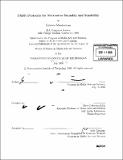| dc.contributor.advisor | Chris Csikzentmihályi. | en_US |
| dc.contributor.author | Shusterman, Gemma (Gemma Lester) | en_US |
| dc.contributor.other | Massachusetts Institute of Technology. Dept. of Architecture. Program In Media Arts and Sciences | en_US |
| dc.date.accessioned | 2007-05-16T18:31:00Z | |
| dc.date.available | 2007-05-16T18:31:00Z | |
| dc.date.copyright | 2006 | en_US |
| dc.date.issued | 2006 | en_US |
| dc.identifier.uri | http://hdl.handle.net/1721.1/37401 | |
| dc.description | Thesis (S.M.)--Massachusetts Institute of Technology, School of Architecture and Planning, Program in Media Arts and Sciences, 2006. | en_US |
| dc.description | Includes bibliographical references (p. 95-97). | en_US |
| dc.description.abstract | It is often said that we live in a network society. Increased familiarity with technical networks has brought the concept to the forefront of public imagination making the network a dominant trope. Whether inherent or ascribed, topologies seem to appear in social theories, transportation systems, technological structures and biological systems to name only a few examples. Often descriptions of networks combine semantics reflecting both conceptual and physical meaning. Regardless of content, be it conceptualization of power, information between computers, relationships between people or neurons; networks rely on topologies and protocols that locate nodes in relation to one another. In the field of technology certain networks are apparent - the internet and the world wide web constitute easily identifiable examples. In the social sciences, descriptions of relationships between people and even of self identity lend nicely to nodes, edges, curves and vertices. In the blurring of boundaries between disciplines the language of the network also becomes a node of interconnection. Technology, sociology, and various branches of theory reference each other in a search for deeper meaning within disciplines. | en_US |
| dc.description.abstract | (cont.) Protocols for Alternative Sexuality and Sensibility or PASS is a wireless networked system designed to function with a multidisciplinary description of a network in mind, incorporating conceptual implications and technical implementation of networking. PASS is a system which visibly tracks connections in public space based on the embodiment of protocols associated with sexual identity. These user configured devices exchange information with other devices in order to uncover the often hidden interconnections created by the internalization of sexual identity. Sexual identity is represented by several alternative paradigms in addition to the culturally predicated homosexual/heterosexual binary. The resulting connections are made visible via independent graphical displays that indicate the various paradigms and connections at play. PASS shows how dominant cultural networks necessitate counter spaces which exist simultaneously in time and space with the hegemonic structures. It is in the revealing of these alternative spaces that I seek a technology of resistance; by connecting people in these counter spaces we create dynamic modes for understanding the influence of normativity and the experience of otherness. The physical representation of these theories reveal the hegemonic protocol structures of interconnection which we internalize as social norms. | en_US |
| dc.description.statementofresponsibility | by Gemma Shusterman. | en_US |
| dc.format.extent | 97 p. | en_US |
| dc.language.iso | eng | en_US |
| dc.publisher | Massachusetts Institute of Technology | en_US |
| dc.rights | M.I.T. theses are protected by copyright. They may be viewed from this source for any purpose, but reproduction or distribution in any format is prohibited without written permission. See provided URL for inquiries about permission. | en_US |
| dc.rights.uri | http://dspace.mit.edu/handle/1721.1/7582 | |
| dc.subject | Architecture. Program In Media Arts and Sciences | en_US |
| dc.title | PASS: protocols for alternative sexuality and sensibility | en_US |
| dc.title.alternative | Protocols for alternative sexuality and sensibility | en_US |
| dc.type | Thesis | en_US |
| dc.description.degree | S.M. | en_US |
| dc.contributor.department | Program in Media Arts and Sciences (Massachusetts Institute of Technology) | |
| dc.identifier.oclc | 122932055 | en_US |
